Under the Radar’s 2023 Holiday Gift Guide, Part 1: Tabletop Games
The Latest in Unplugged Entertainment
As we step into the month December, we suddenly find ourselves knee-deep in the holiday season. To help reduce a little bit of the stress many feel during these most festive weeks of the year, we’re unveiling our annual breakdown of gift suggestions that will hopefully inspire a few ideas, and help you come up with the perfect presents for your friends and loved ones. Like in years past, Under the Radar’s 2023 Holiday Gift Guide will be broken up across several categories—so keep checking back over the coming days as new sections are added to our homepage, and made accessible through the link above!
Today’s gift guide takes aim at analog gaming, with a selection of some of the year’s best new roleplaying and board game releases. Any of the below would make for great gifts, or just something fun to spread out across the table later this month once all of the holiday dishes have been cleared away.
If you’re looking for a gift for a fellow music fan—and if you’re reading us, we’re guessing you might know a few of those—a subscription to Under the Radar will not only keep them up on the latest and greatest in indie music, but help to keep the magazine running for years to come.
And now, bring on the tabletop games…
Dungeons & Dragons
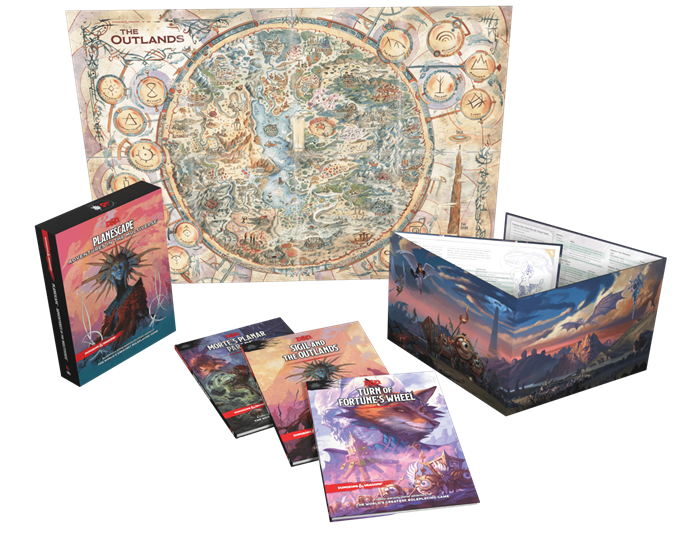
Planescape: Adventures in the Multiverse (Wizards of the Coast)
RRP: $85 (physical only), $95 (physical & digital bundle)
Dungeons and Dragons’ big box release of the year takes players back to Planescape—a classic setting that spans multiple universes centered around the “City of Doors,” Sigil. The books in this set give players and their DMs new worlds to explore over their interdimensional adventures, as well as new monsters, treasures, and even a few character options making their debuts here within the game’s 5th Edition.
Looking back at the late ‘90s, I wasn’t worried about what the Y2K bug would do to the world’s economy or communications systems: I was worried about what it would do to my CRPG saved games. I spent those years hooked on thee sensational D&D computer games we were treated with, including Baldur’s Gate, Icewind Dale, and Neverwinter Nights. My favorite of them all, though, was Planescape: Torment. The game had a macabre sense of humor and Morte, your talking, floating skull sidekick, was an unforgettable NPC. And the way the story spanned multiple lifetimes—your amnesiac hero had histories with the game’s other characters, but from previous reincarnations he couldn’t recall—was a really neat mode of storytelling that made this game unlike any other. That was my only exposure to the Planescape setting, but it was so good that I’ve never forgotten it. Thus, I was particularly excited to dig into the Adventures in the Multiverse box.
The first of its three books is Sigil and the Outlands, which is more or less intended as the introduction to Planescape for 5E. The first part of the book is primarily about the hub city of Sigil, its inhabitants, and its silent, creepy, all-powerful leader, the Lady of Pain; the second part delves into the many Outer Planes and the people and things that occupy them. This is the book that players will be allowed to dig into. Fancy playing as a multi-planar zealot, looking to impose your ideology across the multiverse? Look no further than this tome.
Morte’s Planar Parade is the bestiary for this set—and, hey! Is that my old pal, Morte? It is! The wisecracking skull provides commentary on many of Planescape’s oddest creatures and nastiest monsters. This is the best bestiary—BESTiary?—we’ve seen in years, with some really cool critters. Our favorite might be the Time Dragons which, at their oldest and most powerful, can bend time itself to suit their needs—sending heroes forward into the future or back to the past.
The bestiary’s pretty darn cool, but it’s not the coolest part of this set. That would be Turn of Fortune’s Wheel, the campaign book included in Adventures in the Multiverse.
D&D’s best campaign books stop you in your tracks and make you think, “Man, I want to run this right now.” That’s Turn of Fortune’s Wheel. Spoiling as little as possible, the players have been killed before the adventure’s even begun—they wake up in a crypt beneath Sigil suffering from cosmic amnesia, already a few levels deep into their character’s progression. (Sound familiar? You’ve probably played Torment, too.) They’ll be thrown into an adventure that tasks them with repairing a glitch in the multiverse, where death itself isn’t the end—and sometimes it’s barely an inconvenience. Okay, we’ll stop talking there… but we will say that this adventure turns several preconceived notions of adventuring on their head. It’s nutty, and there are DMs who are really going to relish that aspect of it. It won’t be the heaviest campaign book on their shelf or the most detailed—Fortune’s Wheel asks its DMs to fill out bigger gaps than other adventures—but it’s nothing an experienced DM can’t handle, and that extra freedom is something they may even welcome.
If you’re going to splurge on one big D&D-related gift this year, we’d recommend you make it this set. (Buy it here.)
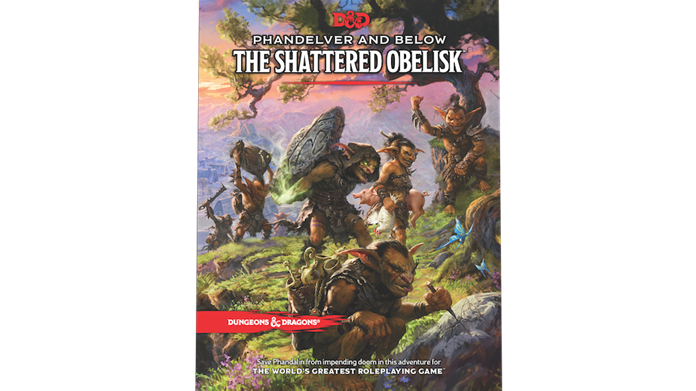
Phandelver and Below: The Shattered Obelisk (Wizards of the Coast)
RRP: $60 (physical only), $70 (physical & digital bundle)
Phandalin is your idyllic fantasy village—a place where alchemists and blacksmiths ply their trades, ale pours cold in cozy taverns, and troubles feel well beyond yonder mountains. It’s the kind of place a new adventurer can get their feet wet in the dungeon-diving game, being nowhere near as hostile or dangerous as some of the starting locations you’ll find in other D&D modules. Chances are that Phandalin is going to be familiar to many gamers, as it’s the central location from The Lost Mines of Phandelver, the introductory adventure from the D&D 5E starter set. Phandelver and Below is an updated and expanded version of what was most players’ first taste of 5th Edition, and proves that something dark lurks below the surface of this quaint little town.
The first chunk of Phandelver and Below is essentially a remake of that original adventure, made bigger and better with more detail and changes that reflect the development that 5E has undergone in the near-decade since its debut. That part will take new characters up to level five. (And it’s still a great introduction to the game.) The second chunk of the book is all-new, diving into a secret conspiracy happening right under the noses of Phandalin’s citizens—one that will not only alter the villagers’ minds, but transform their physical bodies. It’s pretty trippy, and provides some fun, reality-bending tools for the dungeon master to throw at their players.
Phandelver and Below would make a great gift for that busy DM you know: the one who is always launching new campaigns and onboarding first-time D&Ders. They might even be the one who introduced you to D&D. Chances are, they’ve run the starter set version of this adventure multiple times. This book will not only upgrade a story and setting they’re already familiar with, but give them a really intriguing direction in which to take it the next time they break in a new party. (Buy it here.)
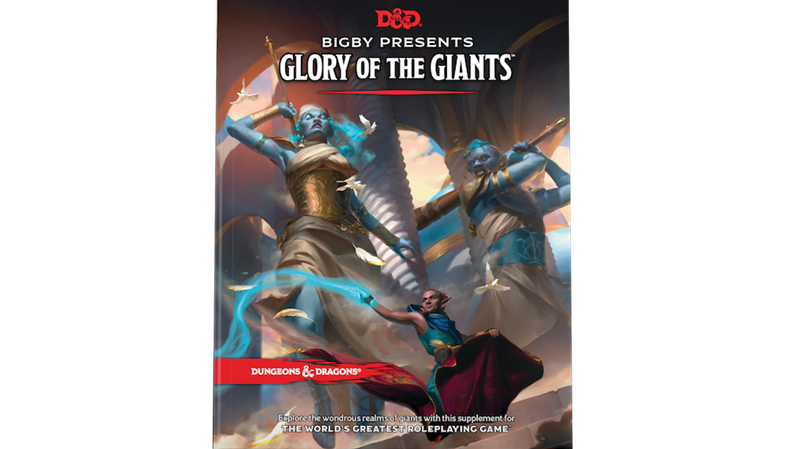
Bigby Presents: Glory of the Giants (Wizards of the Coast)
RRP: $60 (physical only), $70 (physical & digital bundle)
Speaking of your friendly neighborhood DM, this supplemental book for Dungeons and Dragons will provide them a juicy box of super-sized toys to play with. Giants are among the oldest races in many Dungeons and Dragons settings, and it’s not all that out of the ordinary to find remnants of their ancient civilizations while out on an adventure. Giants themselves are less common, but don’t have to be: Glory of the Giants offers up the tools to work these gentle (and sometimes not-so-gentle) behemoths into almost any campaign. There are detailed descriptions of the different types of giants as well as breakdowns of the hierarchy of giant societies; a lengthy, map-filled section with locations custom-built to be filled with these humongous NPCs; tables of oversized treasures, encounters, and adventure hooks; plus a robust bestiary of new monsters (including dinosaurs!)
It’s not just for DMs, however: one of the most fun chapters is full of subclasses and character backgrounds so that you can play a hero with ties to giants or their culture. If playing a dwarven barbarian who wields a giant’s dinner knife as a broadsword sounds as fun to you as it does to us, then Glory of the Giants may be just for you. (Buy it here.)
Role Playing Games
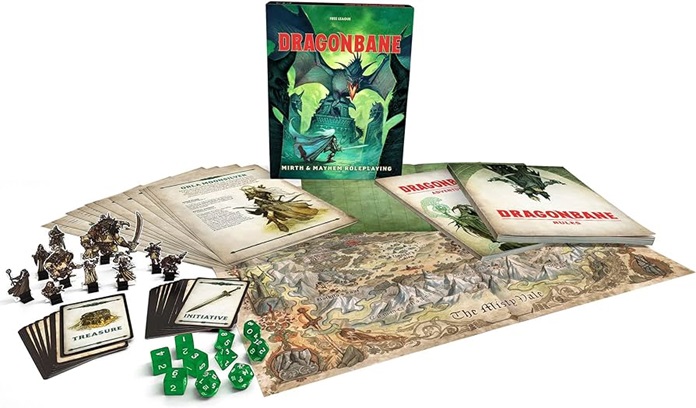
Dragonbane Core Set (Free League Publishing)
RRP: $50 (box set)
For those who miss the good ol’ days of tabletop roleplaying, it doesn’t get more oldschool than this! Dragonbane is a reinvented version of Drakar och Demoner, a classic Swedish TTRPG that debuted all the way back in the early 1980s. Like one of the starter sets you’d buy from your local hobby shop back in the day, Dragonbane’s core set comes stuffed with all the accoutrements that you’ll need to get rolling (literally and figuratively) right out of the box. These include dice, a rulebook, an eleven-adventure campaign, five premade heroes and, perhaps most excitingly, a smorgasbord of cardboard standees delightfully depicting the monsters and characters that’ll populate the set’s gridded battlemap.
You see, Dragonbane was built with speed in mind, with rules that are easy to process and adventures that won’t require tons of prep. If you have a gamemaster who’d like to cut down on work so they can get to the actually roleplaying, Dragonbane is definitely for them. The system’s motto is “mirth & mayhem,” which gives a good indication of the flavor it’s going for. It’s great for a group that welcomes chaos on the tabletop, and won’t mind when their characters meet a horrible (or hilarious) demise. This core set is an affordable gateway into a game that will continue to expand. (Buy it here.)
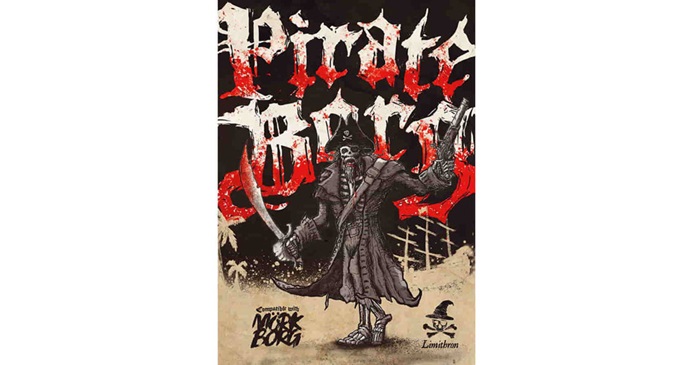
Pirate Borg (Free League Publishing)
RRP: $40
We were big fans of MÖRK BORG—the most metal TTRPG ever created—when Free League unleashed it on the world back in 2020. Famous for its brutal difficulty, the over-the-top darkness in its theming, and its unique (and frequently insane) art style, it was as if somebody set out to create the exact sort of evil game that our aunts and schoolteachers thought we were all playing during the moral panic surrounding D&D in the 1980s.
MÖRK BORG’s seen a couple spinoffs over these last three years, each of which adapted its hardcore ruleset and killer aesthetic to a different setting, including CY_BORG (cyberpunk) and Death in Space (hard sci-fi). Pirate Borg is the latest member of the Borg family, setting players up for swashbuckling, seafaring adventures where their characters will no doubt be killed quickly and often. Pirate Borg also serves as a toolbox full of tables to help you create your own pirate-y adventures for other game systems, as well as an art object in its own right. More so than any other gamebooks we’ve encountered, the wild layouts and illustrations in the Borg books are a pleasure to flip through even when you aren’t going to be playing them any time soon. (Buy it here.)
Board Games

Zhanguo: The First Empire (Hachette Games/Sorry We Are French)
RRP: $70
Zhanguo takes players back to the early days of the Chinese empire, when Qin Shi Huang (founder of the Qin dynasty) conquered the other six regions of China and made himself emperor over all of them. During his reign, things such as laws, writing, measurements, and currency were widely standardized across the lands; fortifications were linked and bolstered to form one Great Wall of China; and a massive terracotta army was assembled to guard his tomb throughout the afterlife.
The Euro-style strategy game Zhanguo: The First Empire focuses on his ruling years, with each player taking on the role of head of one of the court’s influential families. Through myriad means they’ll compete to be the biggest helper to the Emperor’s causes, and have their name inscribed amongst his terracotta soldiers and remembered for all of history.
We usually wait until the end of an entry to say who we’d recommend a game for, but here it’s worth saying up front: Zhanguo is the gift for that hardcore board gamer in your social circle. This is for the person who doesn’t just dabble in games, but makes them a regular part of their life; the ones who love learning complex rules and discovering the cleverness in their intricacy, and who welcome repeat plays of a game as they attempt to master its interwoven systems. Some people will have read that last sentence and thought it sounded like work. Others will have read it and thought, that sounds fun. Zhanguo: The First Empire is a game for those latter folks—and it’s one they’re gonna love.
Like a lot of good heavyweight games, Zhanguo: The First Empire has a lot going on. Players will be managing a hand of cards that can either be played to a personal tableau, for future bonuses, or exchanged for taking one of six actions on the central board, where they’ll be jockeying for area majority—buuuuut, there’s an ever-changing board state which utilizes numbers listed on the bottom of every card to dictate how powerful any given action can be. You need to think tactically and pivot constantly in your race to achieve a variable set of goals before your opponents get to them.
If you’re going to be looking at a game’s components for two-ish hours every time it hits the table, it’s helpful when they’re as gorgeous as the ones in Zhanguo. The cards are nicely illustrated, and the map board itself is quite attractive—especially once it’s littered with the game’s many colorful, wooden, and individually-stamped pieces. Throw in a handful of excellent quality-of-life upgrades such as thick, recessed player boards, and you’ve got a game that’s not just a wonderfully layered tactical puzzle, but one that will feel like a luxury object whenever your lucky giftee gets it to the table. (Buy it here.)

Earth (Inside Up Games)
RRP: $50
In Earth, players work to build out personal tableaus of cards that represent some of the many varieties of flora that populate our planet. By the end of a game, you’ll have grown a 4x4 garden with a unique assortment of plants, sprinkled with an arrangement of colorful cubes and towers, and packing abilities that trigger long, chaining combos not just on your turns, but those of your opponents.
There are elements of Earth that bring to mind Terraforming Mars and Wingspan, two of the hobby’s bigger hits from the last decade. You’re building up an engine from a massive deck of cards—each one gives you a new, incremental advantage over your opponents, and has the potential to grow exponentially if you play your cards right. Earth emphasizes cards that continue to trigger during your opponents’ turns, and there’s almost no downtime in a game because every time you do something, your tablemates get to take a similar action. There’s no waiting around, meaning there’ll be a constant sense of engagement through the entire play session.
And, boy, is Earth a handsome game! The box is full of wooden bits and bobs, and you get an extra feeling of achievement when your plants’ growth is represented by a slowly growing tower of pieces. The cards themselves reminded us of seed packets, with their colorful artwork and plentiful iconography. Earth is a game we’d recommend to a broad variety of gamers—serious gamers will jump on its combo systems, but it’s easy enough to teach (and pretty enough to look at) that it might even snag the more casual members of your gaming circle. It hits a sweet spot that’s far too tough to find. (Buy it here.)
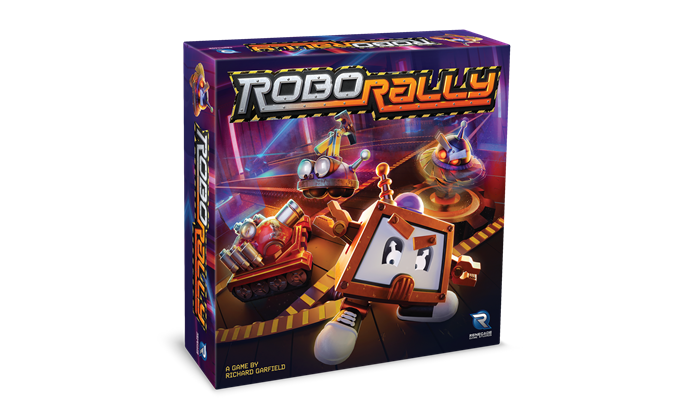
Robo Rally (Renegade Game Studios)
RRP: $50
Did you know that games legend Richard Garfield developed Magic: The Gathering as part of a deal to get Robo Rally published? That’s right: the most influential tabletop game since D&D might never have existed had Garfield not been asked to come up with a low-budget card game to offset the higher manufacturing costs of this title right here. Crazy little bit of trivia, huh? While Robo Rally may forever be overshadowed by Garfield’s other, industry-changing game, it’s a downright classic in its own right, currently approaching its 30th anniversary and the subject of this loving and well-deserved overhaul from Renegade Games.
In Robo Rally, players race their little robot figures through variable factory maps full of checkpoints, conveyor belts, and hazards. It runs through a really fun programming mechanism. Players choose cards in advance that will dictate their robot’s movement; however, the course or your position might change before your turn plays out, meaning that your well-intentioned movements could, say, send your poor ‘bot hurtling over a cliff instead of over the finish line. This frequent, unintentional self-destruction is always good for a laugh, making for a game that’s strategic yet casual; silly, and sometimes cut-throat. With just a few rules modifications, you can even play it as a family game.
Renegade’s fantastic new edition of Robo Rally already has a great rollout of support lined up, including expansion maps. Longtime fans will appreciate some helpful rules tweaks, the double-sided boards, and the pre-painted miniatures which sure look a lot better than the ones I painted (poorly) from my childhood copy of the game. And if you’ve missed out on previous versions of Robo Rally, this is a great place to jump in. (Buy it here.)
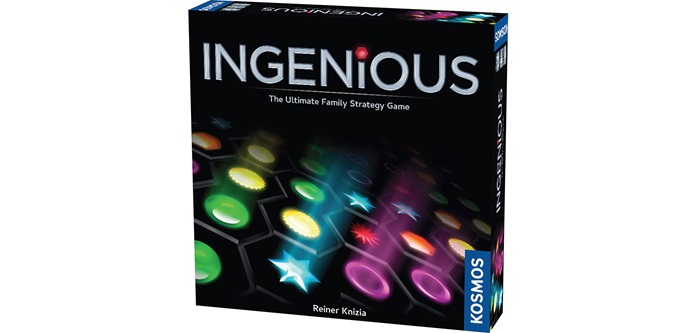
Ingenious (KOSMOS)
RRP: $40
Looking for a game you can set up in seconds, and teach in two minutes? Ingenious is a classic Reiner Knizia design that is ridiculously approachable, yet full of chewy tactical decisions. The rules couldn’t be simpler: you have a hand of six paired hexagon tiles. (Think: dominoes, but with five connection points on each side.) On your turn, you play one of those tiles anywhere on the board, it just has to touch a matching color/symbol. After you place it, count up the matching colored symbols that extend from your tiles in a straight line in any direction and you score that many points for that color. Draw a new tile, and the next player takes their turn. Keep this up until you’ve run out of room on the board, and then compare your scores to find the winner.
Ingenious has a pretty ingenious twist. (See what I did there?) At the end of the game, each player’s lowest-scoring color is their *final* score. You’re not battling for the most points overall, but working to have the most well-rounded assortment of points in each color.
If you know someone who could use a family-weight strategy game that’s juicy enough to keep playing after the kids have gone to bed, Ingenious fills that role very nicely. (Buy it here.)
Books
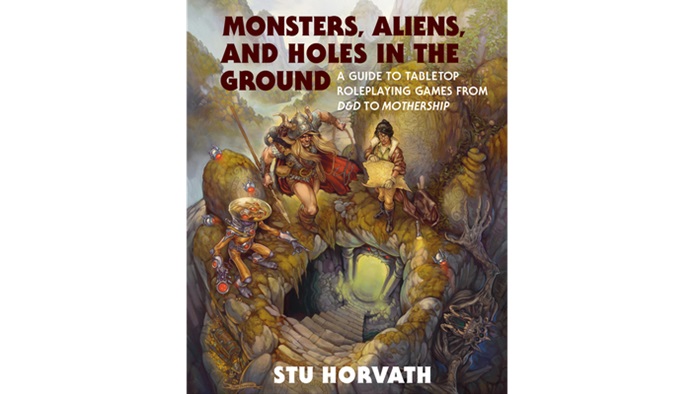
Monsters, Aliens, and Holes in the Ground: A Guide to Tabletop Roleplaying Games from D&D to Mothership (The MIT Press)
RRP: $49.95
I’m going to severely date myself here, but I fell in love with roleplaying in the late 1980s—when a friend’s older brother, tasked with keeping three younger boys out of trouble while his parents left us home alone, ran us through our first D&D session. It was an eye-opening experience that quickly turned into one of my first youthful obsessions. It wasn’t long before I received a rough, split-cornered copy of the classic, red-boxed D&D Basic Set and was busy sketching up my own trap-filled dungeons to play through with friends.
Back in those formative roleplaying years, we played with whatever we could get our hands on. Most of our books were hand-me-downs from older siblings who’d graduated to 2nd Edition. My exposure to the larger world of TTRPGs came courtesy of an independent bookshop with a musty, disorganized, yet robust roleplaying section. It was stuffed full of copies of used starter sets, one-off modules, fantasy magazines, and more mismatched booklets than one could ever possibly count or inventory. There was so much more than just D&D to be found there, and the possibilities were fascinating.
Stu Horvath’s Monsters, Aliens, and Holes in the Ground is an exploration of tabletop roleplaying’s fifty-ish year history, from the earliest D&D publications through TTRPGS of the late 2010s. Through more than 400 heavily-illustrated pages, it provides an insightful look at the hobby’s nonstop development throughout the decades: how one game would inspire the next that would inspire the next, the trends that arose and disappeared just as quickly, and the way that these things tended to follow cycles. Best of all, though, it’s just as interested in examining weird, wild, and near-forgotten games from the past as it is the big name, heavy-hitters that shaped the industry. In here you’ll find write-ups on things like Bunnies & Burrows—a Watership Down-inspired game from roleplaying’s early days—and a tabletop RPG adaptation of the primetime soap opera, Dallas. (I need to track that one down.) Personally, I was reminded of Champions, a superhero-themed game I haven’t thought about in 25+ years, and memories of specific caped heroes we dreamed up as kids came flooding back to me in ways I never imagined possible.
Monsters, Aliens, and Holes in the Ground is a thoroughly engaging history of the TTRPG as a large-scale hobby, and for older readers, will feel like a trip back through time. Author Stu Horvath shares his vast insight on how roleplaying has evolved over the last half-century, along withtons of artwork from their sprawling game collection. This is not just an excellent reference volume, but a super fun read. (Buy it here.)
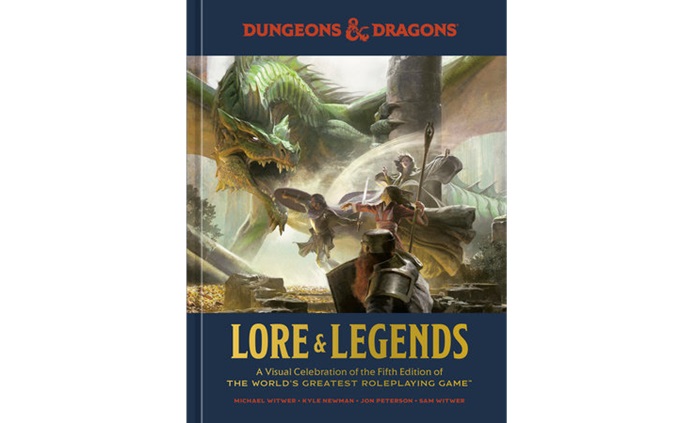
Dungeons and Dragons: Lore & Legends (Ten Speed Press)
RRP: $50
As D&D’s fifth edition has been around for nearly a full decade at this point, it’s easy to forget the low place the game had sunk to just before it debuted. D&D’s popularity had fallen off a cliff, and those who stuck around through fourth edition were left with a game that felt more focused on a needlessly convoluted combat than a shared storytelling experience. D&D had grown stale, and worse: inaccessible. Wizards of the Coast, the publishers of the game since the late ‘90s, decided it was time to hit the ‘reset’ button. The next edition would streamline the rules and reconnect with players both new and old.
And boy howdy, did they nail their goals! Dungeons and Dragons is easier to learn and more popular than ever, and so much of that is thanks to how fifth edition can be learned largely on the fly—and the sort of “greatest hits” approach they’ve taken with its many modules, which have brought back some of the most popular characters, settings, and adventurers from previous editions. Lore & Legends is a massive, 400-page celebration of D&D’s last decade, chock full of artwork and behind-the-scenes materials that track fifth edition from its development and playtesting phase all the way through last year’s book releases, up to the new Dungeons and Dragons movie. It also serves as a guide to the vast range of D&D product currently out there, going book-by-book to preview their storylines and themes, and explain how they tie together. It also makes for a lovely shelf companion to the Dungeons and Dragons: Art & Arcana book, which Ten Speed published a few years back and was a favorite in gift guides past. (Buy it here.)
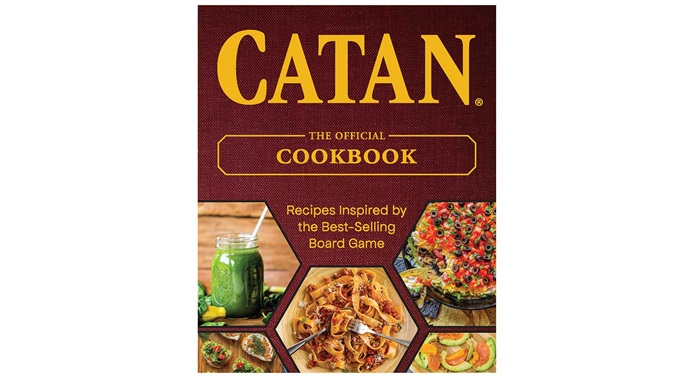
CATAN: The Official Cookbook (Ulysses Press)
RRP: $29.95
If you polled a random selection of board game enthusiasts and had them name the game that pulled them head-first into the hobby, we’d bet a pretty high percentage of them would say The Settlers of Catan (also known simply as CATAN in more recent editions.) It served as the gateway drug for an entire generation of gamers, and paved a way for the countless Euro-style strategy games which have gained worldwide popularity since. Without CATAN, the hobby wouldn’t be what it is today.
CATAN: The Official Cookbook contains more than 75 thematically-appropriate recipes for your next game night, ranging from a savory rack of lamb to sweet, hex-shaped cookies that match the tiles from the game. (We appreciated the long section full of finger snacks, perfect not just for CATAN but really any game night, as well as the dozen different cocktail recipes that are included for when you’re hosting game night after the kids go to bed.) Full of mouth-watering photos and easy-to-follow directions, this book will provide a boost to any host’s evening. (Buy it here.)
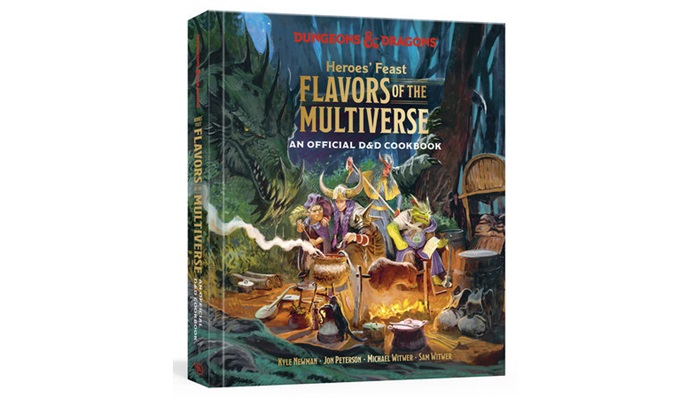
Dungeons & Dragons: Heroes’ Feast – Flavors of the Multiverse (Ten Speed Press)
RRP: $35
I’ll be honest: my dinner table is used far more often for gaming than eating these day. But why not combine the two? Heroes’ Feast - Flavors of the Multiverse is the official D&D cookbook, and comes stuffed with thematic recipes that’ll fit in whichever 5E campaign setting your adventure takes place, from the Forgotten Realms to Ravenloft, from the outer planes all the way to outer space (as seen in Spelljammer.)
What’s fun about this cookbook is that the flavor doesn’t just come from the recipes: it comes courtesy of a quartet of in-universe characters who provide commentary on the dining experience. (Think: Gordon Ramsay and Guy Fieri, but a goblin and a dragonborn, respectively.) This book supplies recipes for everything from frosty mugs of butternut beer—perfect for sipping hearthside—to oldschool iron rations, the sustenance of many players’ earliest D&D adventures. Flavors of the Multiverse is superbly illustrated with both photography and artwork, making parts of it feel like a campaign module where stat blocks have been replaced with ingredients lists. Your D&D host will get a kick out of this, even if they don’t cook—and if they don’t, hey, maybe it’ll inspire them to provide something more than pretzels at your next D&D session? That’d be a win for everyone at the table. (Buy it here.)
Current Issue

Issue #72
Apr 19, 2024 Issue #72 - The ‘90s Issue with The Cardigans and Thurston Moore
Most Recent
- Miki Berenyi Trio Share Debut Single “Vertigo” (News) —
- I’m totally fine with it don’t give a fuck anymore (Review) —
- Villagers Shares Lyric Video for New Song “I Want What I Don’t Need” (News) —
- Watch Fontaines D.C. Perform “Starburster” on “The Tonight Show Starring Jimmy Fallon” (News) —
- Premiere: Layzi Shares New Single “eventually” (News) —

Comments
Submit your comment
There are no comments for this entry yet.